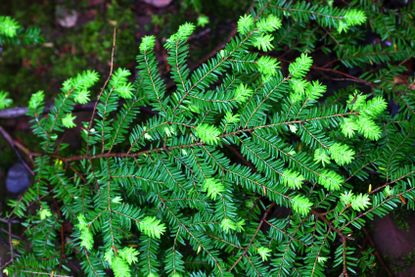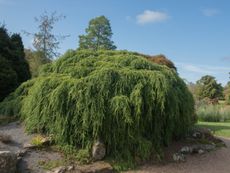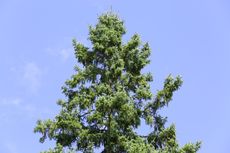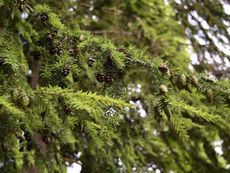Canadian Hemlock Care: Tips On Planting A Canadian Hemlock Tree


If you are thinking of planting a Canadian hemlock tree in your garden, you’ll need information on the tree’s growing requirements. Read on for Canadian hemlock tree facts, including tips for Canadian hemlock care.
Canadian Hemlock Tree Facts
Canadian hemlock (Tsuga canadensis), also called eastern hemlock, is a member of the pine family and native to North America. You’ll see the trees in the wild growing on woody slopes, rocky ridges, and river valleys from eastern Canada south to Georgia and Alabama. They have a slow to medium growth rate of up to 24 inches (61 cm.) a year, maturing to 50 to 70 feet (15-21 m.) tall and 25 feet (8 m.) wide. Don’t worry about their roots. According to Canadian hemlock tree facts, the roots are not likely to invade pipes or raise sidewalks. If you are hesitant to plant this tree because you know hemlock is poisonous, stop worrying. No part of the Canadian hemlock is poisonous. The poisonous hemlocks you have heard about are perennial plants in the parsley family.
Canadian Hemlocks in the Landscape
Canadian hemlocks in the landscape have flat sprays of lacy evergreen foliage and graceful, pyramid shapes. Their elegance makes them excellent choices for specimen trees. However, the trees are very tolerant of shearing. This means that you can also keep them short or use them for privacy screens. When you are thinking about planting a Canadian hemlock tree, it’s important to make sure you live in a region where the species can thrive. In general, this species does well in cooler to cold climates and thrives in USDA plant hardiness zones 3 through 7. If you are planting a Canadian hemlock tree, look for a site that offers some shade. The trees prefer partial shade, especially in areas with hot summers, but do require daily direct sun. If your region gets strong winds, pick a planting spot with wind protection. To offer the best Canadian hemlock care, plant your tree in well-drained loam or sand. The soil should be acidic rather than alkaline.
Care for Canadian Hemlock Trees
If you’ve been careful about your planting location, care for Canadian hemlock trees is not difficult. The most important part of Canadian hemlock care is proper irrigation. When the tree is young, it will require regular watering. As it matures, it still requires frequent irrigation during dry weather. Canadian hemlocks are not very drought tolerant. Care for Canadian hemlock trees can also require regular pruning if you wish to keep the tree a particular size or shape. It is not necessary for the trees’ health, however. Although these trees are hardy to zone 3, their roots do better with protection against the winter chill. The best care for Canadian hemlock trees includes applying a thick winter mulch. If you live in Virginia, Maryland, or Pennsylvania, or other areas where infestations of woolly adelgid have been severe, remain vigilant. These are tiny, sap-sucking insects that can kill Canadian hemlocks. Treatment includes pesticides containing imidacloprid or dinotefuran.
Gardening tips, videos, info and more delivered right to your inbox!
Sign up for the Gardening Know How newsletter today and receive a free download of our most popular eBook "How to Grow Delicious Tomatoes."

Teo Spengler has been gardening for 30 years. She is a docent at the San Francisco Botanical Garden. Her passion is trees, 250 of which she has planted on her land in France.
-
 Urban Composting Guide: How To Compost In The Middle Of The City
Urban Composting Guide: How To Compost In The Middle Of The CityUrban composting does not have to be daunting. You can compost in the city, and maybe even try some urban worm composting!
By Mary Ellen Ellis
-
 Shrub Diseases And Pests To Watch Out For
Shrub Diseases And Pests To Watch Out ForShrub diseases and pests can be challenging. Learn how to recognize and eradicate them before they can present a danger to your plants.
By Susan Albert
-
 Weeping Hemlock Varieties – Information About Weeping Hemlock Trees
Weeping Hemlock Varieties – Information About Weeping Hemlock TreesWeeping hemlock (Tsuga Canadensis "Pendula"), also known as Canadian hemlock, is an attractive evergreen tree with a graceful, weeping form. This article provides information about planting a weeping hemlock in your garden.
By Mary H. Dyer
-
 What Are Wooly Adelgids: Learn About Hemlock Woolly Adelgid Treatment
What Are Wooly Adelgids: Learn About Hemlock Woolly Adelgid TreatmentHemlock woolly adelgids can seriously damage or even kill hemlock trees. Is your tree at risk? Click here to find out.
By Jackie Carroll
-
 Hemlock Tree Care: Tips For Growing Hemlock Trees
Hemlock Tree Care: Tips For Growing Hemlock TreesIf you can get hemlocks to thrive in your landscape, you'll be the envy of your neighbors, but a hemlock in poor health will only make your home look sad and worn out. This article will help with growing hemlocks.
By Kristi Waterworth
-
 Pruning Hemlock Trees - How And When To Prune Hemlocks
Pruning Hemlock Trees - How And When To Prune HemlocksMost of the time, pruning hemlocks is not necessary, but occasionally the need for pruning hemlocks does arise. Find out how to prune a hemlock using the information found in this article.
By Heather Rhoades